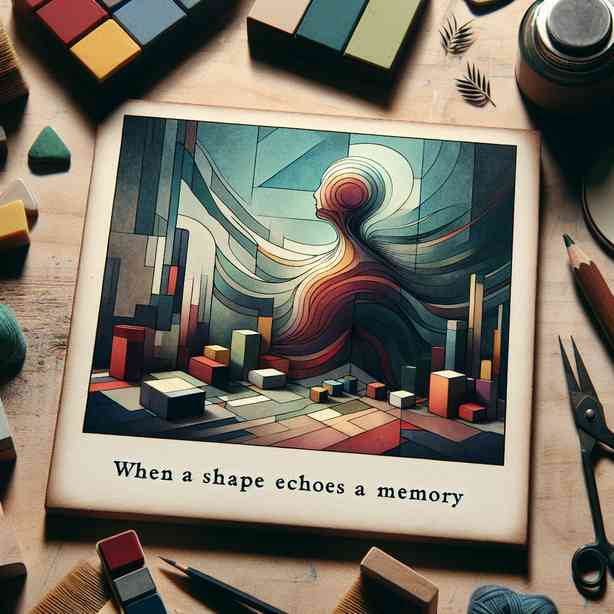
In exploring the concept of memory, one often overlooks the profound relationship between shapes and the reminiscences they can evoke. This intricate connection is woven into the fabric of human experience, linking the physical and the metaphorical in ways that are both subtle and impactful. Shapes, whether seen in architecture, nature, or design, can serve as powerful triggers for recollection. They are not merely physical forms; rather, they carry emotional weight and significance, often associated with specific times, places, or feelings.
A major aspect of this phenomenon lies in the psychological influence that shapes can have on our memories. For instance, the simple outline of a house may conjure feelings of nostalgia for one’s childhood, complete with vivid images of family gatherings and shared laughter. Shapes can act as vessels for memory, holding associations that go beyond their physical appearances. This interplay between form and feeling invites deeper contemplation on how we interact with our surroundings.
When we think about architecture, the contours and designs of buildings often embody collective memories of communities and cultures. A cathedral’s soaring spires or a town’s quaint cottages may invoke a sense of belonging or heritage. Each unique shape carries stories that resonate with those who encounter them, deepening their connection to a specific location. This illustrates how architectural forms are more than just functional constructs; they shape our experiences and reinforce our mental narratives.
Beyond constructs of human design, nature offers a plethora of shapes that hold memories in equally profound ways. The spiraling form of a nautilus shell might remind someone of a family beach vacation or a calming day spent at the ocean’s edge. Meanwhile, the jagged outlines of mountain peaks can evoke a sense of adventure, recalling memories of hikes and breathtaking views. In recognizing these connections, one can appreciate the emotional landscape created by nature’s shapes as they unfold in our personal histories.
Art also serves as a rich domain for exploring the relationship between shapes and memory. Artists often utilize geometric forms or organic lines to elicit emotional responses from their audience. A painter may choose circular shapes to symbolize unity and continuity, whereas angular forms might convey conflict or tension. Each choice in shape can guide the viewer’s emotions, evoking memories that resonate on a personal or collective level. This dynamic underscores the power of shapes in artistic expression and their ability to tap into the human psyche.
Moreover, the digital age has transformed our interaction with shapes and memory. In a world driven by technology, shapes have taken on new dimensions within virtual environments. Designers and developers create immersive worlds that manipulate shapes to evoke specific emotions or responses. For instance, a soft, rounded interface may suggest accessibility and comfort, while sharp, angular designs could provoke feelings of urgency or tension. As we navigate these digital spaces, our memories intertwine with the shapes we encounter, offering new avenues for recall and reflection.
In addition to individual experiences, cultural perspectives play a crucial role in how shapes are perceived and remembered. Different societies attribute various meanings to shapes, influenced by their historical and social contexts. For instance, in some cultures, circles symbolize eternity, while squares may represent stability and order. Understanding these cultural nuances enriches our appreciation of how shapes encapsulate memory across diverse backgrounds. It invites us to consider the shared human experience, where shape and memory blend into a tapestry of stories.
Furthermore, the therapeutic applications of shapes in relation to memory are increasingly recognized in fields such as psychology and art therapy. Practitioners harness the power of shapes to engage individuals in recalling and processing memories, particularly in cases of trauma or loss. Through activities involving shape recognition or creation, individuals can unlock memories that may have been buried, allowing for healing and personal growth. This avenue demonstrates the therapeutic potential of shapes, emphasizing their role not only as physical entities but as conduits for emotional exploration.
As we navigate our daily lives, it is essential to remain aware of the shapes that surround us and their ability to evoke memories. Simple encounters with everyday forms—a skyline, a tree, or even a piece of furniture—can trigger a cascade of recollections. By being attuned to this connection, individuals can cultivate a deeper understanding of themselves and their experiences.
In conclusion, the relationship between shapes and memory is a profound exploration of the human experience. Shapes serve not only as visual elements but as significant markers of our past, interweaving with our emotions and stories across various aspects of life. From architecture to art, and nature to technology, the resonance of shapes carries with it a wealth of memories, inviting us to reflect on our journeys. By appreciating and recognizing this interplay, we can deepen our connection to both the shapes around us and the intricate tapestry of our own reminiscences. As we continue to engage with shapes in our environment, let us remain mindful of the memories they evoke, creating richer narratives within our lives.


